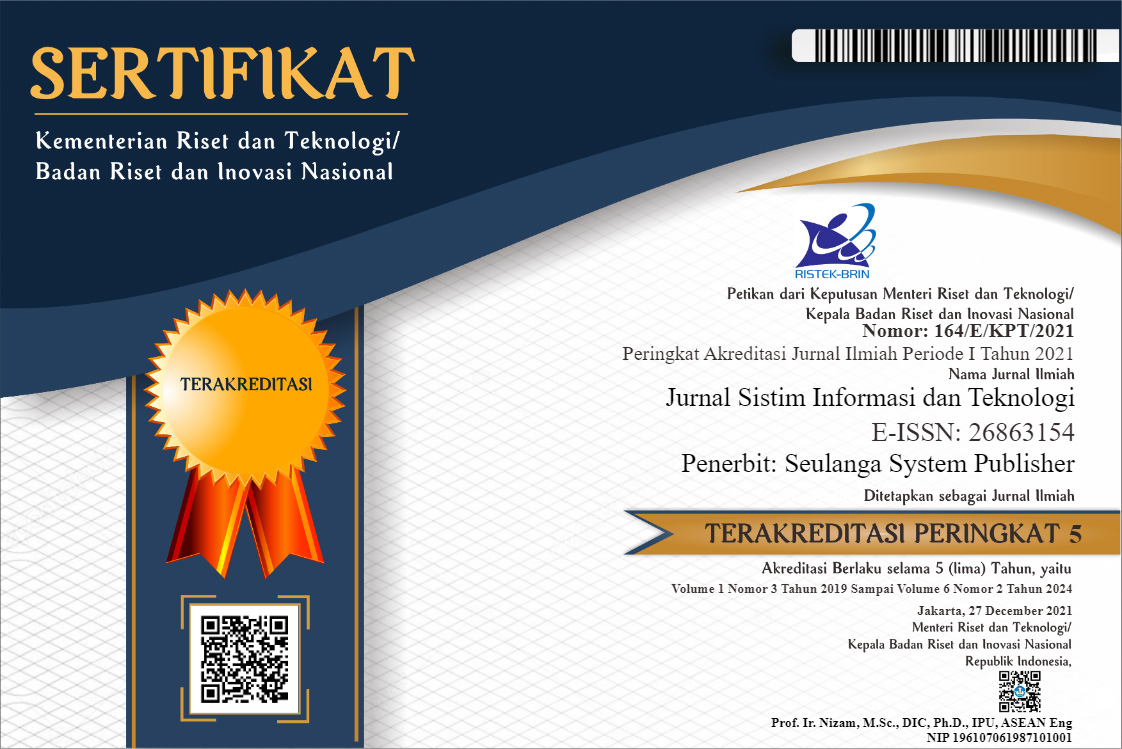Akurasi Klasifikasi Pengguna terhadap Hotspot WiFi dengan Menggunakan Metode K-Nearest Neighbour
DOI:
https://doi.org/10.37034/jsisfotek.v3i3.55Keywords:
K-Nearest Neighbour, Hotspot, Accurate, Receive Signal Strength (RSS), Access PointAbstract
The Current wireless technology is used to find out where the user is in the room. Utilization of WiFi strength signal from the Access Point (AP) can provide information on the user position in a room. Alternative determination of the user's position in the room using WiFi Receive Signal Strength (RSS). This research was conducted by comparing the distance between users to 2 or more APs using the euclidean distance technique. The Euclidean distance technique is used as a distance calculator where there are two points in a 3-dimensional plane or space by measuring the length of the segment connecting two points. This technique is best for representing the distance between the users and the AP. The collection of RSS data uses the Fingerprinting technique. The RSS data was collected from 20 APs detected using the wifi analyzer application, from the results of the scanning, 709 RSS data were obtained. The RSS value is used as training data. K-Nearest Neighbor (K-NN) uses the Neighborhood Classification as the predictive value of the new test data so that K-NN can classify the closest distance from the new test data to the value of the existing training data. Based on the test results obtained an accuracy rate of 95% with K is 3. Based on the results of research that has been done that using the K-NN method obtained excellent results, with the highest accuracy rate of 95% with a minimum error value of 5%.
References
Angreni, I. A., Adisasmita, S. A., Ramli, M. I., & Hamid, S. (2018). Pengaruh Nilai K Pada Metode K-Nearest Neighbor (KNN) Terhadap Tingkat Akurasi Identifikasi Kerusakan Jalan. Rekayasa Sipil, 7(2). DOI: https://dx.doi.org/10.22441/jrs.2018.v07.i2.01 .
Sadli, M., Fajriana, F., Fuadi, W., Ermatita, E., & Pahendra, I. (2018). Penerapan Model K-Nearest Neighbors dalam Klasifikasi Kebutuhan Daya Listrik Untuk Masing-Masing Daerah Di Kota Lhokseumawe. Jurnal ECOTIPE, 5(2), 11–18. DOI: https://dx.doi.org/10.33019/ecotipe.v5i2.646 .
Yudha, D. P., Hasbi, B. I., & Sukarna, R. H. (2018). Indoor Positioning System Berdasarkan Fingerprinting Received Signal Strength (RSS) Wifi dengan Algoritma K-Nearest Neighbor (K-NN). ILKOM Jurnal Ilmiah, 10(3), 274–283. DOI: https://dx.doi.org/10.33096/ilkom.v10i3.364.274-283 .
Firdaus, F., Ahmad, N. A., & Sahibuddin, S. (2019). Fingerprint Indoor Positioning Based On User Orientations and Minimum Computation Time. Telkomnika (Telecommunication Computing Electronics and Control), 17(4), 1740. DOI: https://dx.doi.org/10.12928/telkomnika.v17i4.12774 .
Ghassani, F., Abdurohman, M., & Putrada, A. G. (2018). Prediction of Smarthphone Charging Using K-Nearest Neighbor Machine Learning. 2018 Third International Conference on Informatics and Computing (ICIC). DOI: https://dx.doi.org/10.1109/iac.2018.8780497 .
Dari, Y. E., Suyoto, S. S., & Pranowo, P. P. (2018). Capture: A Mobile Based Indoor Positioning System Using Wireless Indoor Positioning System. International Journal of Interactive Mobile Technologies (iJIM), 12(1). DOI: https://dx.doi.org/10.3991/ijim.v12i1.7632 .
Wiyono, S., & Abidin, T. (2018). Implementation Of K-Nearest Neighbour (KNN) Algorithm to Predict Student’s Performance. Simetris: Jurnal Teknik Industri, Mesin, Elektro dan Ilmu Komputer, 9(2), 873–878. DOI: https://dx.doi.org/10.24176/simet.v9i2.2424 .
Lee, S., Kim, J., & Moon, N. (2019). Random Forest and Wifi Fingerprint-Based Indoor Location Recognition System Using Smart Watch. Human-Centric Computing and Information Sciences, 9(1). DOI: https://dx.doi.org/10.1186/s13673-019-0168-7 .
Sugianto, C. A. (2015). Penerapan Teknik Data Mining Untuk Menentukan Hasil Seleksi Masuk SMAN 1 Gibeber Untuk Siswa Baru Menggunakan Decision Tree. TEDC, 9(1). DOI: https://dx.doi.org/10.31227/osf.io/vedu7 .
Oktanisa, I., & Supianto, A. A. (2018). Perbandingan Teknik Klasifikasi dalam Data Mining Untuk Bank Direct Marketing. Jurnal Teknologi Informasi dan Ilmu Komputer, 5(5). DOI: https://dx.doi.org/10.25126/jtiik.201855958 .
Zafari, F., Gkelias, A., & Leung, K. K. (2019). A Survey of Indoor Localization Systems and Technologies. IEEE Communications Surveys & Tutorials, 21(3), 2568–2599. DOI: https://dx.doi.org/10.1109/comst.2019.2911558 .
Zhang, S. (2019). Research on Heilongjiang Supply Chain Finance Development Model Based on Fast K-Nearest Neighbor Algorithm. 2019 International Conference on Virtual Reality and Intelligent Systems (ICVRIS). DOI: https://dx.doi.org/10.1109/icvris.2019.00080 .
Narulita, L. F. (2017). Analisa Sentimen Pada Tinjauan Buku dengan Algoritma K-Nearest Neighbour. Konvergensi, 13(2). DOI: https://dx.doi.org/10.30996/konv.v13i2.2758 .
Musthafa, A. R., Ginardi, R. V. H., & Arunanto, A. (2016). Sistem Navigasi Indoor Menggunakan Sinyal Wi-Fi dan Kompas Digital Berbasis Integrasi dengan Smartphone Untuk Studi Kasus pada Gedung Bertingkat. Jurnal Teknik ITS, 5(2). https://dx.doi.org/10.12962/j23373539.v5i2.17407
Tinh, P. D., & Mai, T. T. N. (2020). Mobile Indoor Positioning System Utilizing WiFi RSSI and Motion Data. 2020 4th International Conference on Recent Advances in Signal Processing, Telecommunications & Computing (SigTelCom). DOI: https://dx.doi.org/10.1109/sigtelcom49868.2020.9199021 .
Sendari, S., Widyaningtyas, T., & Maulidia, N. A. (2019). Classification of Toddler Nutrition Status with Anthropometry using the K-Nearest Neighbor Method. 2019 International Conference on Electrical, Electronics and Information Engineering (ICEEIE). DOI: https://dx.doi.org/10.1109/iceeie47180.2019.8981408 .
Diono, M., Styorini, W., & Azwar, H. (2018). Sistem Deteksi Posisi Pada Area Indoor Menggunakan GSM Fingerprinting. Jurnal Elementer, 4(1), 9–16. DOI: https://dx.doi.org/10.35143/elementer.v4i1.1577 .
Nugraha, A. R. D., Auliasari, K., & Pranoto, Y. A. (2020). Implementasi Metode K-Nearest Neighbor (KNN) Untuk Seleksi Calon Karyawan Baru (Studi Kasus : BFI Finance Surabaya). JATI (Jurnal Mahasiswa Teknik Informatika), 4(2), 14–20. DOI: https://dx.doi.org/10.36040/jati.v4i2.2656 .
Julita, R. (2020). Algoritma K-Nearest Neighbour dalam Mengklasifikasi Penilaian Peserta Didik. JSAI (Journal Scientific and Applied Informatics), 3(3), 149–155. DOI: https://dx.doi.org/10.36085/jsai.v3i3.1163









